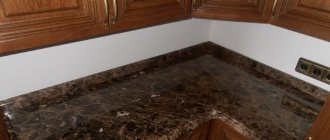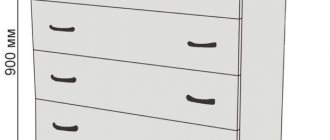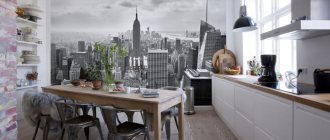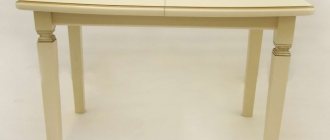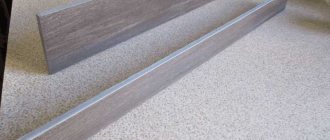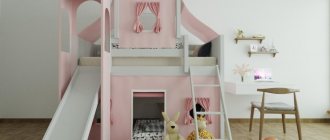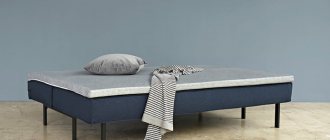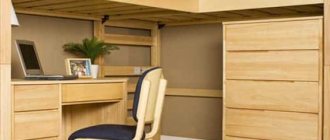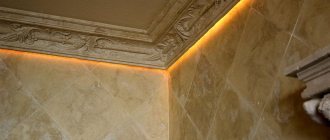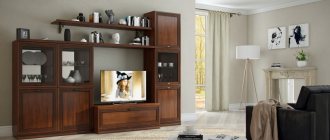No. 1. How to choose the color of the baseboard?
First, we pay attention not to the shape or material of the plinth, but to its color, so this parameter is always given the greatest importance. There are several approaches to choosing the color of the baseboard:
- to match the color of the flooring - the classic and most common method that allows the baseboard to merge with the floor. The likelihood of ruining the interior is reduced to a minimum, so this method is recommended for all those who are wary of bold, contrasting solutions. It is allowed to use skirting boards that are one or two shades lighter or darker than the floor covering. This option is great when the room uses solid boards, parquet, laminate or linoleum;
- match the color of the walls. This option is only possible if the walls are painted or plastered. one color. It is advisable to choose a plinth already when the coating has been applied and dried, otherwise you may not guess with the shade;
- match the color of the interior doors, but in this case the height of the plinth should be the same as the width of the door frames. Often this method is used when it is necessary to organically fit a door into the interior that does not match the color of the walls, furniture or floor. To make it look really good, you can make the color of the window frame, doors and baseboard the same;
- contrasting shade, which does not repeat the color of the flooring, the color of the walls, or the color of the doors. In order to correctly combine seemingly incompatible shades, you need to have a subtle sense of taste. You can take white skirting boards, which have recently been in high demand. Whatever it may be, it is still better to create a project for the future interior in advance in a special program and try different shades. There are very easy to use programs.
The influence of wall colors on the choice of baseboards
The imagination of interior designers is truly limitless. A new trend is to select the colors of the baseboards to match the tone of the walls of the room. This technique allows not only to harmoniously fit the floor frame into the interior, but also to visually increase the height of the ceilings, which is especially important in apartment buildings with low ceilings.
Often this technique is used in combination with walls covered with wallpaper for painting, or simply covered with paint of some shade. To achieve a complete match, the baseboards are coated with the same composition as the walls. Optimally suited for these purposes are skirting boards made from LDF, which lend themselves well to painting at home.
As an option, the baseboards are matched to the color of the wallpaper that covers the walls. If the color is not monochromatic, then choose the predominant shade and match the color of the baseboard to it. In this case, it is allowed if the walls and frames are slightly different in shade.
Please note that skirting boards of different colors may have a slightly different visual effect. So, if the color of the frame of the room almost merges with the floor and walls, then the room acquires additional volume, that is, it seems larger. Conversely, if the color of the baseboard contrasts sharply with the floor and walls, the room looks less voluminous, but more elongated.
Finally
Thus, there is no doubt that any plinth under the door or under the floor should not only be selected taking into account the type of floor covering, but also take into account the color scheme of the laying material itself, as well as other decorative elements, such as window frames, ceiling beams, door panels, decoration of walls or ceilings, furniture or lighting.
Skirting boards installed around the perimeter of the room will look most harmonious if they are selected taking into account the rules and recommendations specified in this material. Of course, it is impossible to present all possible options for combining coatings with design in one article, but we were still able to outline the basic principles.
By following the principles used by experienced designers, as well as based on your own sense of style, you can choose the optimal combination of colors so that your interior will delight you for a long time.
A floor plinth is, at first glance, a mere trifle, the choice of which few people pay due attention to. However, the perception of the interior depends on this detail, because the impression is created from little things. In order not to act intuitively, let's figure out how to choose a baseboard for the floor so that it matches the room as closely as possible in width, color, type of material, shape and style. When decorating interiors, professionals pay a lot of attention to skirting boards, perceiving them not only as a functional detail that closes the gap between the floor and the wall, but also as an important element of space, like a door or window. It's time to reveal the secrets of choosing the right floor plinth that designers use.
No. 2. What can a floor plinth be made of?
The second most relevant and important issue when choosing a floor plinth is the question of the material used to make it. In this case, it is best to start from the flooring material:
- wooden plinth is suitable for floors made of block parquet and solid boards, parquet boards, laminate;
- MDF plinth and veneered plinth are suitable for parquet and laminate;
- PVC skirting boards are the cheapest and most popular option, often used with linoleum, tiles and carpet;
- ceramic baseboard Not so long ago it became available in a wide range and goes well with ceramic tiles.
How the choice of baseboard is influenced by the flooring material
In order to competently organize the finishing of the floor, you should take into account what to choose the baseboard for the floor, that is, the material of the floor covering plays an important role in this. You should not combine coatings and baseboards that have different textures, because this not only looks inorganic, but is also impractical from a budget point of view.
There are certain rules for choosing a baseboard for the floor so that it looks appropriate:
- Skirting boards made of veneer or solid wood. Such products are most preferable in combination with floors made of valuable or inexpensive types of wood, in particular, we are talking about parquet or deck boards (more details: “How to choose and install wooden baseboards for the floor”).
- PVC skirting boards. This material is widely used for framing floors covered with linoleum, as the most actively used floor covering. The relevance of plastic skirting boards in this case is quite understandable, because their texture is very similar to this coating. In addition, such skirting boards look no less presentable in tandem with laminate or carpet. In addition, PVC skirting boards belong to the category of inexpensive products.
- Metal skirting boards. Planks made of chrome or regular metal are ideal for finishing floor coverings with porcelain tiles, creating a high-tech style.
- Skirting boards from LDF. Products in this category are optimally combined with laminate, carpet, wood and even ceramic tiles. They recently appeared on sale, however, they have already managed to win the sympathy of consumers. LDF skirting boards can be painted independently in any color, giving the interior the necessary accents.
- Ceramic skirting boards. Of course, this type of finishing is used only in combination with tiled or porcelain stoneware floors in rooms with high levels of humidity. Often, you should not specifically select a plinth for a specific type of tile, since they are made from the same material and in the same color scheme.
No. 3. Wooden plinth: pros and cons
Despite the emergence of many new materials that captivate with their high performance qualities, wood remains at the top of its popularity. In addition, it is difficult to imagine that a wooden floor would be decorated with a baseboard made of non-natural material. Wood is valued due to its many advantages:
- durability;
- environmental friendliness;
- strength;
- excellent appearance;
- ease of installation.
Flaws:
- high price;
- sensitivity to temperature changes and high humidity, which imposes restrictions on the scope of use of the material (it is not suitable for kitchens and baths, but solid wood is used there extremely rarely).
Installation of wooden baseboards is usually carried out using self-tapping screws with flat heads; sometimes screws with dowels are used. The tree is easily cut at any angle, easily attached to the base and removed, and can be repaired. It is important that the wall is perfectly flat, otherwise the wood will quickly deform, and there will be no need to talk about any aesthetic appearance. It is also not recommended to use liquid nails for installation: if the humidity changes, internal tension can be created in the wood, which will tear both the baseboard and part of the wall covering away from the wall.
The wooden plinth is chosen from the same species from which the floor finishing is made, and it is advisable to select the plinth at the same time as choosing the finishing material. As for wood species , pine is the cheapest, oak and linden are more expensive, ash, alder, teak, cherry, walnut, and birch are less commonly used. Fans of exotic and non-standard solutions can turn their attention to merbau or dusiya wood. If the plinth is suspiciously cheap , pay attention to its quality: some manufacturers offer products glued together from three longitudinal layers of wood.
The cross-section of a wooden plinth can be different, as well as its shape and width. Today it is even possible to make custom-made skirting boards , if it is necessary that they accurately follow the curves and other complex areas of the room, but this is an expensive pleasure.
If you plan to open the baseboard with varnish or wax, remember that the wood may change color. To roughly understand what the result will be, you can wet a part of the surface of the untreated baseboard with a sponge.
No. 4. Veneered plinth
Veneered plinth has a structure similar to parquet boards. In it, only the top layer is made of valuable wood (walnut, oak, bamboo, pear, etc.), and the base is made of pine or spruce wood. The advantages and disadvantages are the same as those of a purely wooden baseboard, but the price is slightly lower . The shade and texture of the surface can be anything you want. By the way, today veneered and wooden plinths are equipped with a cable channel for laying electrical wires.
No. 5. MDF plinth
A plinth made of MDF is the golden mean in terms of price and quality . In terms of properties, the material is almost as good as wood, and in some respects it even surpasses it, and at the same time it costs much less. MDF boards are made from sawdust, which is pressed under high temperature and pressure along with urea resins. The result is a durable and non-hazardous material that does not emit harmful substances into the air. The top of the board can be painted, laminated with a film or veneered with a thin layer of natural wood, so the appearance is very varied.
Advantages:
- resistance to moisture and temperature changes;
- UV resistance;
- antistatic;
- ease of installation and maintenance;
- relatively low price.
Flaws:
- strength and mechanical resistance are much lower than that of wood, but higher than that of plastic.
Experts say that MDF skirting boards can be attached to liquid nails, but it is better to use special clamps that are screwed to the wall. Due to this fastening, the plinth can be removed and reused. The slight flexibility of the material allows it to be attached to slightly curved walls.
LDF skirting boards on store shelves . LDF board is manufactured using the same technology as MDF, but has a lower density: 450-650 kg/cm3 for LDF versus 650-850 kg/cm3 for MDF.
No. 6. Hard plastic skirting board
More than half of all those who begin to think about which skirting board to choose end up choosing the plastic option. There are much more such products on store shelves than wooden or veneered ones, because plastic skirting boards look very good and are cheap . These skirting boards are made from foamed polyvinyl chloride; the product can have any color and relief, so choosing the right option will not be difficult, but these are not the only advantages of PVC skirting boards.
Advantages:
- low price;
- resistance to moisture and rot, so this plinth can be used in the bathroom and kitchen, and can also be safely washed without fear of consequences;
- resistance to ultraviolet rays and temperature changes;
- the presence of cavities inside the baseboard, allowing you to hide a lot of cables.
Flaws:
- unnaturalness;
- low durability;
- low mechanical strength.
The plastic plinth consists of a fastening and a front part . It is the fastening part that is mounted to the wall with self-tapping screws, so the front side remains smooth. Between the fastening and front parts there is sufficient space in which electrical wires can be placed, and sometimes there is only enough space for a television cable, and sometimes a whole bundle of wires can be laid , and also divided by partitions for convenience. Special plugs are used at the ends and corners; when choosing, pay utmost attention to them, since they are often very different in color from the baseboard itself.
For carpet flooring, there is a special plastic plinth, which looks like an L-shaped strip into which you need to insert a strip cut from the carpet. As a result, it is possible to completely disguise the baseboard.
Types of skirting boards
The main task when choosing a plinth for laminate flooring is to find a material that will match both the color and texture of the floor covering. The construction market offers a variety of collections of moldings for framing laminate flooring.
- Wooden plinth is environmentally friendly, safe for health, and quite durable. Floor edging is made from pine, spruce, alder, and less often from oak. Natural material in the interior always looks appropriate and, with good care, will last a long time. From a palette of natural shades it is easy to choose a baseboard that will make a successful combination with both laminate and interior doors.
Disadvantages include the high cost of products, water permeability, and lack of flexibility. Installation of such models is possible only along smooth walls and after treatment with water-repellent agents. The wooden surface should not show any damage or dark spots that could affect the durability of the material.
- MDF plinth is a cheaper analogue of wooden models. The advantages include a wide selection of colors and the ability to lay a cable channel. The disadvantages are the same as those of wood edging - low resistance to moisture, lack of flexibility, plus fragility and difficult installation.
- Metal plinth may not be considered as an alternative. It is rarely installed at home; it is more often found in offices and workrooms. This molding has a neutral appearance, is resistant to damage and moisture, and does not require anti-mold treatment or additional painting.
- The most popular type among finishing materials is plastic plinth. Attracted by the affordable price, richness of colors, variety of designs. The convenient design significantly facilitates installation, and moisture resistance makes PVC skirting boards indispensable for edging laminate flooring in the bathroom, kitchen and bathhouse. Plastic models can easily take the shape of any surface in the case of semicircular walls and shaped cutouts.
For information on how to design joints of various configurations, read the article “Threshold for laminate flooring - choosing the right one”
The plastic plinth fits quite tightly to the wall and to the floor surface, protecting the edges of the laminate from moisture getting on them. It's all about the silicone edge, which provides good grip. Produced models are often equipped with cable ducts, special fittings allow all corners to be neatly passed, and open edges are treated with plugs. Despite all the advantages, plastic skirting boards have one serious drawback - they are short-lived.
- Ceramic plinths are rare at home, as are metal ones. In addition, they usually decorate flooring made of tiles or tiles. Usually not used with laminate.
When finishing floors, the master selects the most suitable option for each specific case. Sometimes manufacturers, along with a collection of laminate, also produce finishing materials for it, which makes the search much easier. The most popular frames for laminated coverings are models made of plastic, MDF or wood.
No. 7. Flexible plinth
If the room has a lot of curved and non-standard shapes, then there is no better option than a flexible plastic baseboard. In order for the material to acquire unique properties, during production the spatial structure of the polymer threads is slightly modified, but to preserve such properties, the plinth must be stored in special packaging. Often flexible plinth is produced in the form of a long strip, which allows installation with virtually no seams.
Advantages:
- plasticity and ability to take the required shape;
- moisture resistance and ease of care;
- resistance to temperature changes.
Flaws:
- relatively high cost;
- complexity of installation.
Installation consists of installing a supporting profile, on top of which a flexible front profile is attached. It is preheated in warm water or exposed to hot air until it becomes pliable. After this, it can be fixed into the fastener segments and wait until it hardens itself, taking the required shape.
No. 8. Ceramic baseboard
Just a couple of decades ago, when decorating a room decorated with ceramic tiles, baseboards were made by hand, cutting the same tiles into pieces. It was not always possible to get a smooth edge, so the appearance of such a plinth was not particularly aesthetic. Today, ceramic plinth often comes complete with tiles, has exactly the same color as the main material, and differs only in size, and its width is made so that the seams can be joined. Of course, you can choose a baseboard of a completely different color and a different batch. A curved baseboard is often used between the wall and the bathroom.
Advantages:
- durability;
- resistance to moisture, sunlight, temperature changes, so this is an ideal option for kitchens, bathrooms and hallways;
- stability of shape and size;
- mechanical strength.
Installing a ceramic plinth should not be difficult - the process is similar to laying ceramic tiles. The plinth is mounted with glue and nailed with a light rubber or wooden hammer. The seams are masked with waterproof grout.
Materials for making skirting boards
If the appearance affects the harmonious design of the room, then the durability and installation technology depend on the material of manufacture. What should you pay attention to?
Durability. In all cases, the service life of skirting boards should be 30 years or more. The outer coating must be resistant to infrared radiation, not change color, and be resistant to mechanical stress.
The baseboard must be durable
Easy to care for. The more the surface has relief patterns, the more difficult it is to maintain it in proper form. If the room is often cleaned, it is recommended to choose elements with a flat, smooth surface, preferably matte rather than glossy. Minute scratches are visible on the glossy one.
Skirting board with smooth surface
Resistant to direct contact with water, low coefficients of linear thermal expansion. In bathrooms, kitchens and corridors, wet cleaning is most often done; in addition, these floor coverings have an increased risk of flooding. Skirting boards should not lose their original properties after prolonged contact with water.
Plastic plinth is not afraid of contact with water
Flexibility. If the quality of the walls does not meet the required parameters, then the skirting boards should hide problem areas. After fixing, there should be no gaps between the wall and the element. This is achieved in two ways: by leveling the walls or selecting flexible types of skirting boards. The first method requires a lot of time and special construction measures, and is associated with a large amount of dust and construction debris. Flexible skirting boards make it possible to smooth out uneven surfaces much easier, while visually the walls will appear perfectly smooth.
Floor flexible plinth
Additional functions. In many cases, engineering communications are located along the perimeter of the premises. The baseboard must have special grooves in which television cables and electrical wiring for various low-voltage household appliances are torn off.
Plastic plinth with cable channel
Price. There are no cheap and reliable materials at the same time; this should always be remembered. In some cases, the price of skirting boards is almost equal to the cost of cheap flooring. When choosing, you should always adhere to the universal rule: expensive floors require equally expensive skirting boards and vice versa.
Wide wooden plinth
To make the right decision, you need to familiarize yourself with the types of skirting boards currently available.
What materials are currently used for floor finishing elements?
| Material of manufacture | Performance characteristics |
Plastic | The most popular skirting boards belong to the budget price segment. They consist of two parts, one is attached to the walls with dowels, the second is decorative. Most plastic skirting boards have grooves for cables for various purposes. Advantages - a wide selection of models, relatively low price, plastic does not react to contact with water. Disadvantages: low resistance to mechanical damage. To simplify installation, it has plugs and corners. When purchasing a kit, compare the appearance of all additional elements; quite often they differ. Such products are produced by unscrupulous companies. Skirting boards from the Polish company Arbiton receive positive reviews; to improve the fit, the upper edges have a thin soft strip. |
MDF | Wood waste is used for production, which gives them some naturalness. The external front surfaces are covered with self-adhesive films, giving the skirting boards a different color and texture. In terms of price they are on par with plastic ones. They can be fixed to the walls with dowels or special metal brackets. Disadvantages: low physical strength and instability to high humidity. Fixed with liquid nails, clips or glue. Clips greatly simplify repair work; the damaged area is snapped off and replaced with a new one. The end cuts have special plugs. |
Natural wood | Traditional material with all the advantages and disadvantages of wood. Various species are used for production, from cheap pine to expensive oak or other valuable species. External surfaces can be natural or tinted. To protect against moisture, they are covered with durable polymer-based coatings. When purchasing, you need to pay attention to the class of products; very cheap products are made not from solid wood, but from glued sections. They have differences in structure and shade along the length. One more nuance. After varnishing, the shade of wooden skirting boards changes, keep this in mind when choosing a color. If desired, natural wood plinths can be made to order, but this will cost much more. |
Ceramic tile | Most often used in bathrooms and kitchens, less often in corridors. Ceramic tiles are not afraid of moisture, the glaze has high mechanical strength. Skirting boards can be purchased together with tile collections or separately to give the room an exclusive interior. |
Fake diamond | One of the most expensive types of skirting boards, used in prestigious premises. They occupy leading positions in terms of operational characteristics. When choosing sizes and colors, you need to take into account the parameters of the premises. It is recommended to install artificial stone skirting boards in prestigious rooms with large dimensions. |
Extruded polyurethane foam | They have limited use due to insufficient physical strength. Advantages: low cost and unlimited appearance. Depending on your needs, it is possible to paint the surfaces yourself. |
Flexible plastic | It is made from special types of plastic and sold in rolls. Flexible plinth is used for finishing vertical columns or other architectural elements of complex geometric shapes. |
Veneered board | A cheap option for baseboards made of natural wood. The supporting base is made of low-value wood, the top layer is made of valuable veneer. They have a wide range, in terms of performance parameters they are inferior to natural wood ones, but they are much cheaper. The company Burkle (Germany) has positive recommendations. The thickness of the veneered plinth is 15–22 mm, height up to 80 mm. |
Aluminum | It ranks first in terms of strength; the front surface can be of a natural color or tinted using various methods. It is used in rooms with high traffic, is not afraid of moisture, and the service life is almost unlimited. Maximum strength allows the elements to be installed in public places: train stations, hospitals, etc. |
Suberic | Completely natural, made from cork tree bark by gluing and pressing. Used in conjunction with cork floors. In terms of performance indicators it belongs to the middle category, and in terms of cost it belongs to the elite category. |
Choosing a skirting board
Prices for PVC floor skirting boards
pvc floor plinth
No. 9. Metal baseboard
Aluminum, stainless steel and brass can be used to make skirting boards ; anodized aluminum is, of course, more common.
Main advantages:
- high strength and durability;
- beautiful appearance;
- resistance to mechanical damage, changes in humidity and temperature;
- wear resistance;
- presence of a cavity for laying cables.
Disadvantages include high cost and not compatibility with all materials . An aluminum baseboard will look good with tiles, porcelain stoneware, self-leveling flooring and commercial linoleum. Most often the material is used in public spaces, but is also suitable for kitchens and bathrooms and will complement the high-tech style of the interior.
No. 10. Cork plinth
Cork plinth is far from the most common option. Made from the bark of the cork tree, it is a completely natural material, harmless to health, excellent for those rooms where cork flooring or cork wallpaper was used. The color range is limited, the price is high.
No. 11. Choosing the size of the plinth
The height of the plinth can vary from 3 to 15 cm , and the choice of a specific parameter depends on the size of the room and the height of the ceilings:
- for small, low rooms (with a height of about 2.5 m), it is better to choose thin baseboards 3-5 cm, and the color should preferably match the shade of the walls, so that the baseboard seems like a natural continuation of them;
- for rooms of medium height (about 2.7 m), skirting boards with a height of 4.5-7 cm are suitable, the choice of which is wide;
- V spacious high rooms It is highly not recommended to use narrow skirting boards - it is better to opt for high planks, which will either be contrasting or match the color of the floor covering.
But what if there is still no baseboard?
If you can’t find a plinth, in some cases you can do without it altogether. Then you will have to decorate the interior in such a way that a possible baseboard seems superfluous and unnecessary. Experts advise in this case to use the method of grooves, into which boards (parquet, laminate) or tiles go. But the edges of the flooring will then need to be trimmed with a chrome corner that reflects light. This, of course, is a non-standard and expensive solution. It must be included by the designer in the project from the very beginning and carried out at a high professional level.
However, today it is almost impossible not to “pick up” a plinth. With the existing variety of options, this part can be found for any coating and for any interior. Especially if a real specialist gets down to business. In principle, any unprepared person can choose a plinth if he relies on the rules outlined above and listens to the practical advice of designers and experienced finishers.
( 86 votes, average: 4.80 out of 5)
How to choose a chainsaw: characteristics of chainsaws and review of models
Decorative plaster of the facade: types and rules of application
Related Posts
No. 12. Skirting and interior style
To choose the right plinth, you need to take into account the style of the interior:
- the classic style involves the use of high plinths made of wood or MDF, with a noticeable relief. All wood shades are suitable, especially dark ones, as well as white;
- minimalism involves using the simplest possible baseboard, with a smooth surface, usually white. Material: MDF, metal, less often wood and plastic;
- hi-tech – these are shiny metal skirting boards, plastic or MDF;
- Country style is characterized by an abundance of roughly processed solid wood, and baseboards are no exception;
- For the Art Nouveau with its ornate shapes, a flexible plastic plinth is perfect.
The floor plinth is installed at the end of the finishing work, after installation of the floor and wall coverings. However, even before the renovation begins, it is necessary to at least have a general idea of what color, shape and size the baseboard will be - it is better to choose the final option after all the finishing is done and the final shades of the floor and walls are visible.
Tags:Apartment design, Flooring
Width of baseboards for laminate
When choosing baseboards for laminate flooring, you need to take into account not only the area and height of the room, but also the size of the gap between the floor covering and the wall.
Most often, the distance does not exceed 1 centimeter, however, laminate is characterized by such a feature as gradual screeding - over time, this distance can increase or decrease, depending on the temperature in the apartment.
Sometimes this distance can increase to 1.5 cm. Accordingly, the width of the plinth should reach at least 15 mm so that no gaps form between them and the floor covering.
Another important factor is the wire channel. Its presence will be an important advantage, all for the same reason for changing the size of the floor. If the laminate begins to expand, it may put pressure on the wires, which can lead to breaks and deformation.
You can use skirting boards without a gutter, but in this case it is better to increase the gap to 15-18 mm and use wider skirting boards.
